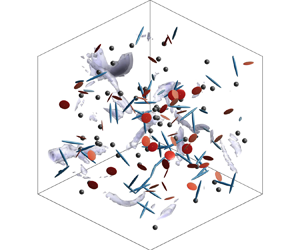No CrossRef data available.
Published online by Cambridge University Press: 18 July 2023

Non-spherical particles transported by turbulent flow have a rich dynamics that combines their translational and rotational motions. Here, the focus is on small, heavy, inertial particles with a spheroidal shape fully prescribed by their aspect ratio. Such particles undergo an anisotropic, orientation-dependent viscous drag with the carrier fluid flow whose associated torque is given by the Jeffery equations. Direct numerical simulations of homogeneous, isotropic turbulence are performed to study systematically how the translational motion of such spheroidal particles depends on their shape and size. It is found that the Lagrangian statistics of both velocity and acceleration can be described in terms of an effective Stokes number obtained as an isotropic average over angles of the particle's orientation. Corrections to the translational motion of particles due to their non-sphericity and rotation can hence be recast as an effective radius obtained from such a mean.